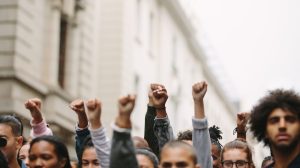Despite recent critically acclaimed and award-winning films like Minari and The Farewell, it appears Hollywood is still woefully slow in creating diverse, inclusive and non-stereotyped roles for its Asian American and Pacific Islander actors.
A new study has found that the majority of roles given to Asian actors in the past decade were problematic in some way, with more than half of Asian film characters serving as comic relief for other characters to laugh at. The study also revealed that when AAPI characters weren’t used for laughs, they embodied “exotic” female roles in which the actors were disproportionately sexualized.
The findings come from a study titled “I Am Not a Fetish or Model Minority,” which was conducted by Mount Saint Mary’s University in California, the Coalition of Asian Pacifics in Entertainment (CAPE) and Gold House, a nonprofit collective dedicated to the more authentic representation of AAPI individuals. To compile the study, researchers studied the top 10 highest-grossing Hollywood films released between 2010 to 2019.
According to a report by Sakshi Venkatraman of NBC News, “the analysis showed that while less than a quarter of the AAPI characters were comedic themselves, audiences were asked to laugh at almost half of them. It suggests that Asians on screen often serve as the punchline or the butt of the joke.”
“Our study provides unique insights into the lived experiences of AAPIs working in Hollywood and the negative stereotypes that have existed on screen for decades,” said Academy Award-winning actress Geena Davis, founder of Mount Saint Mary’s Geena Davis Institute on Gender in Media that led the study.
“There is an enormous gap between how the AAPIs surveyed and those in the broader Hollywood community perceive the meaning of the word representation,” Davis added. “Having the data and these critical insights from the AAPI community will allow us to drive systemic change in entertainment and media.”
In an interview with NBC, sociologist Nancy Wang Yuen blamed popular 1980s era films like Sixteen Candles for the legacy of offensive AAPI character portrayals that persists even today. In that film, actor Gedde Watanabe plays a foreign exchange student who is repeatedly mocked and made fun of on-screen.
“Anything he said was something that you laughed at, not with,” Yuen said. “He kind of defined Asian characters for decades.”
In addition to looking at Hollywood’s depictions of AAPI characters, Venkatraman reported that “the survey also gauged the opinions of 329 Asian Americans in the entertainment industry, revealing that over 93% agree that AAPI representation on screen is inadequate, and 95% feel that representation behind the scenes is inadequate.”
As for overall representation for AAPI individuals, the study revealed that just 4.5% of main cast members in the decade’s worth of films studied were AAPI — and three-fourths were supporting roles.
“That just speaks to the lack of authority that Asians have to be able to tell their own stories in Hollywood and the kind of trope of using Asians as objects,” Yuen told NBC.
“Thirty-five percent of the characters studied fall into tropes or stereotypes like the model minority, which portrays Asian Americans as inherently nerdy and hardworking, the martial artist or the exotic woman,” Venkatraman reported. “Results showed that 17% of female AAPI characters are verbally objectified, and 13% are dressed in hypersexual clothing, more than white or non-Asian counterparts.”
According to Yuen, this impacts how young AAPI women see themselves and their feelings of self-worth.
“We have the intersection of racism and sexism for Asian women who aren’t just disempowered but also exploited,” she told Venkatraman. “It’s really hard for young Asian women to see themselves as leaders or as anything more than that, especially when these images have an impact on the way they’re treated in society.”
Other key takeaways from the report:
- “Stereotypes vary by ethnic groups; South Asian men, for example, are depicted in science fields like medicine, and South Asian women are portrayed as exotic seductresses.”
- “East Asian women are often represented as ‘lotus blossoms,’ innocent girls who are still sexually available, or ‘dragon ladies,’ women who are evil and use their femininity to deceive men.”
- “Of the groups included under the AAPI umbrella, Pacific Islanders and Southeast Asians are rarely on screen compared to South and East Asians.”
Sadly, none of those findings were a surprise to Yuen.
“Hollywood is something that repeats what has worked before. The early representation of Asians were just East Asians, and the stereotypes were the accent, the exotic, the villain. All those tropes have not changed for 100 years,” Yuen said. “That’s why we have an overrepresentation of the stereotype as well as the overrepresentation of East Asians — because Hollywood just reproduces itself.”
Related: For more recent diversity and inclusion news, click here.


















